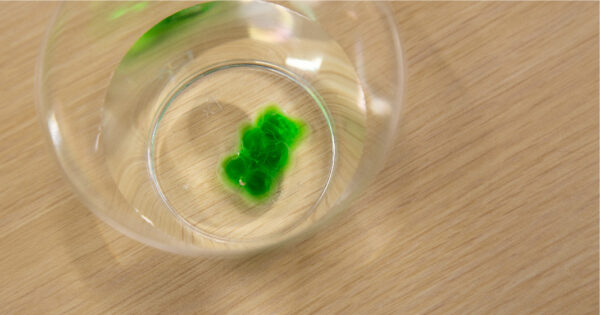
Children are naturally curious about the world around them. They ask tons of questions. One of the best ways to engage that curiosity is with hands-on activities and experimentation, like learning about melting wax through a crayon art project, or making a history timeline to put the past into perspective. Laboratory investigations, on the other hand, can be intimidating, but they are worth the time and effort.
One of the challenges of science is that so much of our world is microscopic, and it is hard to study what we cannot see. Our bodies are composed of millions of tiny cells. Molecules travel across cell membranes. But how do we know that? Have you ever observed osmosis, when water travels from an area of high concentration to an area of low concentration? Although you cannot see the water molecules traveling, you can infer that they do from what happens to a gummy bear left in water.
What is the gummy bear experiment?
The gummy bear experiment is a great way to observe the behavior of liquid solutions using readily available items in your kitchen. And these items are partially edible*!
*Note that you should not consume the water-logged bears that result from your experiment, but feel free to eat your control bears. Bears that sit in water for an extended time may harbor bacteria that could make you sick.
Terms to Learn for the Gummy Bear Experiment
The following scientific terms will help you better understand what is going on and what you’re doing in this experiment.
- solute: a substance that dissolves in water (e.g. salt or sugar)
- control: a bear that you have not treated with any experimental liquid
- solvent: a liquid that dissolves other substances (usually the solvent is water)
- solution: a solute dissolved in a solvent
- super-saturated solution: a solution that has as much solute in it as it can dissolve
- equilibrium: a state of balance, where concentrations of molecules are the same on both sides of a membrane
- osmosis: when molecules (like water) pass through a membrane (or gummy bear) traveling from an area of high concentration to an area of low concentration
- membrane: a thin layer that separates two areas
- semi-permeable: allowing small molecules through but keeping large molecules out
- variables: whatever is different about your experiment and control (for example, size, color, temperature, the liquid you use, the volume of liquid, etc.). You would not want to try to test what the liquid does to the gummy bear if you also start with gummy bears of different sizes or colors. You would not want to put your control in the refrigerator and leave your experiment on the counter. You want the only difference between the two to be the liquid you put the bear into.
What happens in the experiment?
Because gummy bears have no water in them, they contain an area of low concentration of water molecules. When you put a gummy bear in water for a long time, the water will move into the bear by osmosis. The gummy bear is semi-permeable, so the sugar and gelatin stay in the bear. And the water comes in and makes it grow.
Imagine you are in a small room with lots of people of all sizes and shapes. There is standing room only! Now imagine that someone opens the door. What happens next? People will leave the tiny room and spread out. Not only that, but small children may be the first to get out, because they are weaving through the small spaces between larger people (like a semi-permeable membrane) to make a quick exit. The molecules in a chemical solution behave the same way.
- Molecules will spread out to occupy as much space as they have.
- Molecules will move to an area of lower concentration (outside the tiny room) if possible.
- Small molecules can travel through semi-permeable membranes while large ones cannot.
How to Conduct the Gummy Bear Experiment
Begin the gummy bear experiment by discussing what happens to candy when it gets wet, like in your mouth. Your children have probably noticed that most candies will dissolve in their mouths. If not, give them a piece of candy that will dissolve.
Now, what about gummy bears? Take the opportunity to eat one! Gummy bears usually take quite a bit of chewing compared to other candies. Ask your children why they think that is. Then guide them to make predictions about what will happen when you put gummy bears into water and other water-based solutions. Remember to include appropriate controls in your experiment and to test only one variable at a time. Note that since your experiment should not introduce unnecessary variables, you really should use one color of gummy bear. Personally, I don’t like the yellow ones, so devoting them to my experiment would be a great cause.
- Use this opportunity to teach your child project and time management skills.
Hypothesis
Once you have introduced the gummy bear experiment by noticing what happens in your mouth, you can start to form a hypothesis. You have discussed possible predictions about what will happen when you put gummy bears in water. Discuss possibilities for the other solutions you will test as well. Perhaps your children think that gummy bears just don’t stick around long enough in your mouth to dissolve. Your hypothesis might be “the gummy bears will dissolve in water overnight.”
Perhaps your children think that only teeth can physically change the gummy bear, so it will not change in the water overnight. Although that would make for a boring experiment, it is a valid hypothesis! Remember that science is about challenging your hypothesis, so design an experiment that could show you that you are wrong. If you said that gummy bears will “eventually” dissolve, how will you know that your experiment is over and your hypothesis is disproven? How long will you have to wait? Putting a time limit on it, like overnight, makes your hypothesis disprovable without an infinite amount of time.
Materials
- gummy bears (your least favorite flavor)
- a small cup for each experimental solution
- water
- optional liquids
- milk
- vinegar
- soda
- optional solutes
- salt (one tablespoon in a half cup of water, stir to dissolve)
- baking soda (one tablespoon in a half cup of water, stir to dissolve)
- sugar (one tablespoon in a half cup of water, stir to dissolve)
- paper towels
- ruler (or caliper)
- paper/pen
- timer
- kitchen scale
Procedure
1. Gather materials.
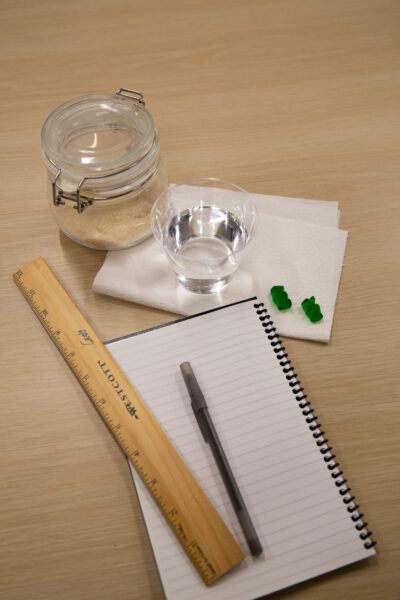
Decide how many liquids you want to test. You might want to start with just water and leave other liquids for follow up questions. My suggestion is to do at least plain water and sugar water so you have two different results to talk about. It is also fine to just test plain water and compare it to your control.
2. Measure the gummy bears.
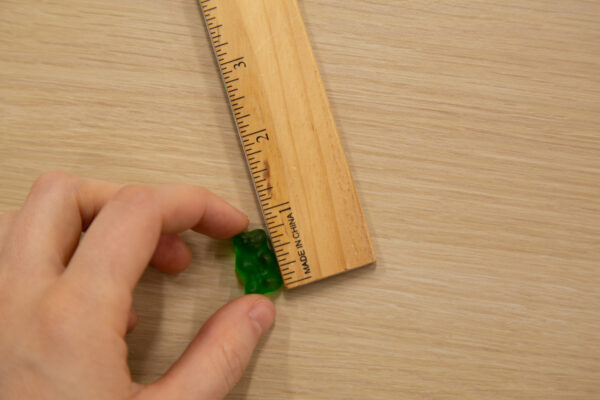
Before you start, you will want to take some measurements and record your results. Use the kitchen scale to weigh the gummy bears. Use the ruler to measure their length, width, and thickness (you might want to try the millimeter scale rather than inches, like a true scientist). If you happen to have a caliper, that will work well for this. Are there large or small differences between gummy bears? Choose gummy bears that are as similar as possible.
3. Measure the test liquid.
How much does a half cup of your test liquid weigh? Record your result.
4. Place the gummy bears in the test liquids.
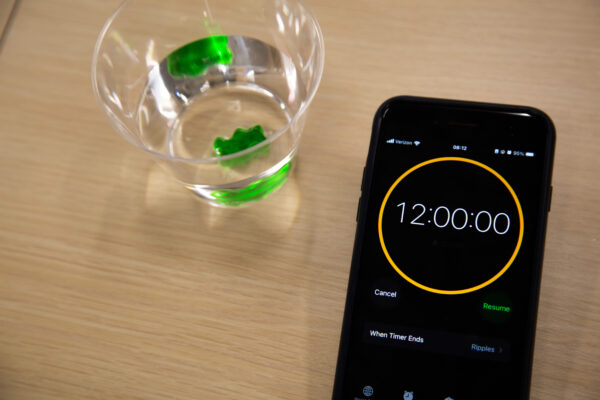
Put each gummy bear into a different liquid, putting one into an empty cup as a control. Set a timer for at least 12 hours, or you can plan to run the experiment overnight. Keep in mind you will need to start early in the day if you want to get results the same day.
5. Measure the gummy bears and test liquids again.
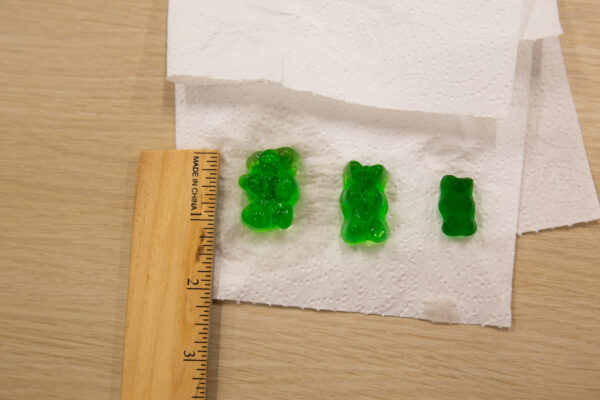
Whatever measurements you took before the experiment, take the same ones after and compare. Plot the two results on a graph. Feel free to put the gummy bears back in the liquids and see if another 12 hours will change them even more. Add these third measurements to your graph. Did all of the liquid you lost from the cup go into the bear?
Gummy Bear Experiment Results
The control gummy bear will not change at all, or very little. If you conduct your experiment on a particularly humid day, the control bear could absorb water from the air. Your bear in water should be about double or triple the size of your control bear. Was your hypothesis disproved? Why do you think you got the results that you did? What will you try next?
You might also notice that the color of your bear has changed. Why do you think that happened? Did the color of your water change, indicating the color might have seeped out of the bear? Or do you simply have a lower concentration of color now that the bear has grown?
Why do gummy bears grow in water?
Gummy bears are not solutes, so they do not dissolve in water. They are gelatin polymers. The interconnected gelatin fibers allow water molecules to enter and exit the gummy bear freely. Because there is an abundance of water in the cup (high concentration) and none in the gummy bear (low concentration), the water experiences osmosis, and the gummy bear grows.
What about in sugar water?
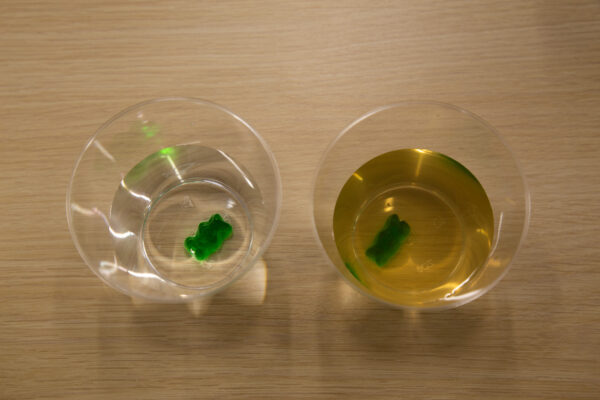
Because of the sugar dissolved in the sugar water, the concentration of water is not as high in that solution. Even though you started with the same amount of water, the sugar water is more similar to the gummy bear than plain water, and so it does not change the gummy bear as much (it reaches equilibrium sooner).
Gummy Bear Osmosis
The polymeric nature of gummy bears acts like a semi-permeable membrane surrounding a cell. Water flows into the gummy bear as it spreads out from an area of high concentration to an area of low concentration. When the water reaches equilibrium, the gummy bear will stop growing, but that does not mean the water molecules have stopped moving. They continue to move back and forth at equal rates.
Going Further
Here are some ideas to take this experiment further:
- Once you have tried water and sugar water, try additional liquids and solutions you can find or make around your house (see materials list for some ideas). After seeing the results of the first experiment, how will your hypothesis change? How will the acidity of vinegar affect the results? Which liquid or solution changes the gummy bear the least? Why do you think that is?
- Make super-saturated solutions. How do you think the concentration of sugar or salt will affect the outcome?
- In a saucepan, bring water to a boil. Add sugar or salt, stirring until dissolved. Continue adding sugar or salt until you have remaining solute that is not dissolving. Pour the super-saturated solution into a heat-resistant bowl or cup to cool. Discard the undissolved solute. Cool the solution to room temperature before using it in your experiment.
- Take measurements of the gummy bears every two or four hours and determine when the experiment reaches equilibrium. Equilibrium will be the point at which the gummy bear does not grow any more. Plot your measurements on a graph. What shape does the plot look like?
- Try a completely different osmosis experiment by putting 3 raw eggs in vinegar overnight. You will see bubbles form on the surface of the egg shell as the vinegar starts to dissolve the shell. In the morning, gently rub the egg shell in a circular motion until all of it is gone. You might need to do this under running water. Leave the eggs in vinegar longer if you are unable to completely remove the shell. Once you have naked eggs, you will be looking at a single cell with a membrane surrounding it! (Note that the yolk is not the nucleus. It is a deposit of nutrients that would have fed the embryo if the egg had been fertilized. The nucleus is invisible.) Place one egg in water, another in an empty cup (control), and the third in corn syrup. Leave them overnight. Water will enter the egg in the plain water experiment and will leave the egg in the corn syrup experiment. Why do you think that happens?
• • • • •
Valerie is a wife and a mother to a very busy preschooler. In her free time she enjoys reading all kinds of books. She earned a B.S. in Biology from Bob Jones University, minoring in Mathematics, and a Ph.D. in Molecular Genetics from Ohio State University. Valerie has 15 years of experience working in research laboratories and has coauthored 8 original research articles. She has also taught several classes and laboratories at the high school and college levels. She currently works as a Data Analyst and a freelance writer.
Leave a Reply